Baffled top piston diesels.
#82

My Feedback: (1)

Surface temperature versus colour for a Steel object.

Derek's picture of the piston and contra of the Polish baffled diesel.
Last edited by qazimoto; 10-19-2018 at 12:53 AM.
#83

Join Date: Jul 2015
Posts: 49
Likes: 0
Received 0 Likes
on
0 Posts
Dont disagree with you Ray, but does your exampled engine pre ignite the mixture before the heat of compression gets a chance to?
Carbon deposits thaat would tend to build up on inside angles would not help matters either.
Google Bull Dog tractors by Lanz to sse how low compression two stroke engine can be fired in a cold state by heating a plug of copper (hot bulb), this supports combustion until residual heat can take over and continue the cycles.
Hobbsie where are you my man!
Carbon deposits thaat would tend to build up on inside angles would not help matters either.
Google Bull Dog tractors by Lanz to sse how low compression two stroke engine can be fired in a cold state by heating a plug of copper (hot bulb), this supports combustion until residual heat can take over and continue the cycles.
Hobbsie where are you my man!
#84

My Feedback: (1)
Dont disagree with you Ray, but does your exampled engine pre ignite the mixture before the heat of compression gets a chance to?
Carbon deposits thaat would tend to build up on inside angles would not help matters either.
Google Bull Dog tractors by Lanz to sse how low compression two stroke engine can be fired in a cold state by heating a plug of copper (hot bulb), this supports combustion until residual heat can take over and continue the cycles.
Hobbsie where are you my man!
Carbon deposits thaat would tend to build up on inside angles would not help matters either.
Google Bull Dog tractors by Lanz to sse how low compression two stroke engine can be fired in a cold state by heating a plug of copper (hot bulb), this supports combustion until residual heat can take over and continue the cycles.
Hobbsie where are you my man!
#85

Join Date: Jul 2015
Posts: 49
Likes: 0
Received 0 Likes
on
0 Posts
Where am I going to Ray? Is this an attempt at a shut down? A thread that has spanned 4 years and extends to 4 pages with most of the posters still present for comment, in my opinion,should still comment.
Um, we are talking about model diesels and surely its forgiven in such an inclusive forum entitled "Everything Diesel" that it actually includes all diesels as a talking point?
And it may surprise you but model diesels will actually run other hydrocarbons and be lubricated quite well with other organic oils or indeed mineral oil and be convinced to cycle without ether if the residual heat present is enough.
Anyway the point is to show that if localised temperature is raised high enough it will cause ignition before the heat of compression has a chance to.
The hot bulb indisputably shows this an I would wager that the "Lanova" cell in fourstrokes would be another example (http://www.rcuniverse.com/forum/ever...nova-cell.html) and finally here, its a possibilty that a baffle running at an elevated temperature may do the same.
No proof that it does and no proof that it doesnt so parallels and conjecture are all we have here, and a narrowing of any focus would limit discussion, wouldnt you agree?
Thanks.
And it may surprise you but model diesels will actually run other hydrocarbons and be lubricated quite well with other organic oils or indeed mineral oil and be convinced to cycle without ether if the residual heat present is enough.
Anyway the point is to show that if localised temperature is raised high enough it will cause ignition before the heat of compression has a chance to.
The hot bulb indisputably shows this an I would wager that the "Lanova" cell in fourstrokes would be another example (http://www.rcuniverse.com/forum/ever...nova-cell.html) and finally here, its a possibilty that a baffle running at an elevated temperature may do the same.
No proof that it does and no proof that it doesnt so parallels and conjecture are all we have here, and a narrowing of any focus would limit discussion, wouldnt you agree?
Thanks.
Last edited by Chris W; 10-21-2018 at 07:35 PM.
#86

My Feedback: (1)
Where am I going to Ray? Is this an attempt at a shut down? A thread that has spanned 4 years and extends to 4 pages with most of the posters still present for comment, in my opinion,should still comment.
Um, we are talking about model diesels and surely its forgiven in such an inclusive forum entitled "Everything Diesel" that it actually includes all diesels as a talking point?
And it may surprise you but model diesels will actually run other hydrocarbons and be lubricated quite well with other organic oils or indeed mineral oil and be convinced to cycle without ether if the residual heat present is enough.
Anyway the point is to show that if localised temperature is raised high enough it will cause ignition before the heat of compression has a chance to.
The hot bulb indisputably shows this an I would wager that the "Lanova" cell in fourstrokes would be another example (http://www.rcuniverse.com/forum/ever...strokes-2.html) and finally here, its a possibilty that a baffle running at an elevated temperature may do the same.
No proof that it does and no proof that it doesnt so parallels and conjecture are all we have here, and a narrowing of any focus would limit discussion, wouldnt you agree?
Thanks.
Um, we are talking about model diesels and surely its forgiven in such an inclusive forum entitled "Everything Diesel" that it actually includes all diesels as a talking point?
And it may surprise you but model diesels will actually run other hydrocarbons and be lubricated quite well with other organic oils or indeed mineral oil and be convinced to cycle without ether if the residual heat present is enough.
Anyway the point is to show that if localised temperature is raised high enough it will cause ignition before the heat of compression has a chance to.
The hot bulb indisputably shows this an I would wager that the "Lanova" cell in fourstrokes would be another example (http://www.rcuniverse.com/forum/ever...strokes-2.html) and finally here, its a possibilty that a baffle running at an elevated temperature may do the same.
No proof that it does and no proof that it doesnt so parallels and conjecture are all we have here, and a narrowing of any focus would limit discussion, wouldnt you agree?
Thanks.
These are my two most recent acquisitions from a local deceased estate.
Both nib, a Doonside Mills, and a mk2 Rossi glow. I have a spare Rossi diesel head button to convert it. Actually it comes with a stock factory glow button with integral coil.


#87
The problem is that what we, as modellers, call a diesel is incorrect. Our "diesels" are more correctly called a compression ignition engine. True diesels work quite differently. Our "diesels" need the ether to ignite the kero which is the ingredient that gives the power. The ether also is necessary to allow castor to mix with the kerosene.
#88

Join Date: Jul 2015
Posts: 49
Likes: 0
Received 0 Likes
on
0 Posts
Ageed, but calling the forum "Everything Homogenous Charge Compression Ignition" is bit of a mouthfull!
And I would wager that calling it "Everything Diesel" more accurately echoes businesses that use the same moniker.
And I would wager that calling it "Everything Diesel" more accurately echoes businesses that use the same moniker.
#89

Join Date: Jul 2005
Location: Upper HuttWellington, NEW ZEALAND
Posts: 1,601
Likes: 0
Received 1 Like
on
1 Post
There are hand held remote sensing IR thermometers out there in modeldom now-mainly for the benefit of the R/C car guys who are rather cavalier in their treatment of engines-it would be a simple job to borrow one of these to get a feel for the running temperature of a diesel-obviously the piston and cylinder will run a lot hotter that the exterior-but taking readings at different locations on the engine-and the exhaust gas temp will give a fairly indicative answer to the sort of temperatures we are talking about during operation..I with Ray on this-I doubt we get much beyond 200C in normal operation.
ChrisM
'ffkiwi'
ChrisM
'ffkiwi'
#90

Join Date: Jul 2015
Posts: 49
Likes: 0
Received 0 Likes
on
0 Posts
From the FMV treatise, cylinder walls near the combustion chamber can run at 250C. Any higher and the oil vapourises.
Makes sense that the upper limit on any sliding surface must be lower than the point that the oil breaks down.
Still think that the fin that has about 80% of its surface area exposed to combustion gases that burn at about 1000C and the remaining 20% attached to the hottest part of the engine, the piston crown, just may run a lot hotter. Note that I said 'surface' (and to be specific the exhaust side of the fin) and dont see a heat soak that effects the greater mass of the piston that much due to the cycling of the scavange cooling the mass back down to an average.
(As a parrallel, a glow plug glows red hot but does the whole engine follow?)
Put it this way, if you wanted to attract heat to the piston crown there would be no better way to engineer it than to add finnage with no cooling surface to transfer the heat away.
Getting into flogging dead horses territory again without some kind of evidence of running piston crown temps.
Makes sense that the upper limit on any sliding surface must be lower than the point that the oil breaks down.
Still think that the fin that has about 80% of its surface area exposed to combustion gases that burn at about 1000C and the remaining 20% attached to the hottest part of the engine, the piston crown, just may run a lot hotter. Note that I said 'surface' (and to be specific the exhaust side of the fin) and dont see a heat soak that effects the greater mass of the piston that much due to the cycling of the scavange cooling the mass back down to an average.
(As a parrallel, a glow plug glows red hot but does the whole engine follow?)
Put it this way, if you wanted to attract heat to the piston crown there would be no better way to engineer it than to add finnage with no cooling surface to transfer the heat away.
Getting into flogging dead horses territory again without some kind of evidence of running piston crown temps.
#91

Join Date: Jul 2005
Location: Upper HuttWellington, NEW ZEALAND
Posts: 1,601
Likes: 0
Received 1 Like
on
1 Post
[QUOTE=Chris W;12474767]From the FMV treatise, cylinder walls near the combustion chamber can run at 250C. Any higher and the oil vapourises.
Makes sense that the upper limit on any sliding surface must be lower than the point that the oil breaks down.
Still think that the fin that has about 80% of its surface area exposed to combustion gases that burn at about 1000C and the remaining 20% attached to the hottest part of the engine, the piston crown, just may run a lot hotter. Note that I said 'surface' (and to be specific the exhaust side of the fin) and dont see a heat soak that effects the greater mass of the piston that much due to the cycling of the scavange cooling the mass back down to an average.
(As a parrallel, a glow plug glows red hot but does the whole engine follow?)
Put it this way, if you wanted to attract heat to the piston crown there would be no better way to engineer it than to add finnage with no cooling surface to transfer the heat away.
Getting into flogging dead horses territory again without some kind of evidence of running piston crown temps.[/QUOTE
Well for a start the glowplug glows red hot from a combination of catalytic action with methanol (which is readily demonstrated with a beaker of methanol and some platinum wire) -and residual combustion heat-but the rest of the plug doesn't-again the non contact thermometer could tell you this-or a thermal scan of a running-and a 'just stopped' engine...if you did a timed scan you could see the heat flows as the engine cooled to ambient-and you seem to have entirely overlooked the screamingly obvious-how could the baffle possibly be red hot when every cycle it is directly hit by the incoming cool fresh charge as the transfer opens? At best-you could expect a slight temperature differential between the transfer side of the baffle and the exhaust side-and since this particular baffle is a fence type, not a contoured type-not much even of that-the thermal mass would be too small...
ChrisM
'ffkiwi'
Makes sense that the upper limit on any sliding surface must be lower than the point that the oil breaks down.
Still think that the fin that has about 80% of its surface area exposed to combustion gases that burn at about 1000C and the remaining 20% attached to the hottest part of the engine, the piston crown, just may run a lot hotter. Note that I said 'surface' (and to be specific the exhaust side of the fin) and dont see a heat soak that effects the greater mass of the piston that much due to the cycling of the scavange cooling the mass back down to an average.
(As a parrallel, a glow plug glows red hot but does the whole engine follow?)
Put it this way, if you wanted to attract heat to the piston crown there would be no better way to engineer it than to add finnage with no cooling surface to transfer the heat away.
Getting into flogging dead horses territory again without some kind of evidence of running piston crown temps.[/QUOTE
Well for a start the glowplug glows red hot from a combination of catalytic action with methanol (which is readily demonstrated with a beaker of methanol and some platinum wire) -and residual combustion heat-but the rest of the plug doesn't-again the non contact thermometer could tell you this-or a thermal scan of a running-and a 'just stopped' engine...if you did a timed scan you could see the heat flows as the engine cooled to ambient-and you seem to have entirely overlooked the screamingly obvious-how could the baffle possibly be red hot when every cycle it is directly hit by the incoming cool fresh charge as the transfer opens? At best-you could expect a slight temperature differential between the transfer side of the baffle and the exhaust side-and since this particular baffle is a fence type, not a contoured type-not much even of that-the thermal mass would be too small...
ChrisM
'ffkiwi'
#92

Join Date: Jul 2015
Posts: 49
Likes: 0
Received 0 Likes
on
0 Posts
Hi Chris,
I have already admitted that I dont know what color temperature the fence is ( Quote - "I admit that I dont know for certain the color temperature of the metal but if its accepted that the heat of the baffle is enough to trigger ignition then what color would you pick? ") and regret using the phrase "red hot"- it was more a figure of speech since really, none of us know what temp it could run at.
But the gases coming up from the transfer passage are usually a mix of spent combustion gases that bounce back off the incoming charge quite significantly and the evaporative cooling effect may not be what is expected because of preheating and diluting of the charge.
And no, I have not missed the screamingly obvious, small pressure and heat differentials have great meaning in small engines.
How does one burn and pit a piston crown and yet millimetres away the cylinder wall does not suffer the same effect?
Much we dont know.
I have already admitted that I dont know what color temperature the fence is ( Quote - "I admit that I dont know for certain the color temperature of the metal but if its accepted that the heat of the baffle is enough to trigger ignition then what color would you pick? ") and regret using the phrase "red hot"- it was more a figure of speech since really, none of us know what temp it could run at.
But the gases coming up from the transfer passage are usually a mix of spent combustion gases that bounce back off the incoming charge quite significantly and the evaporative cooling effect may not be what is expected because of preheating and diluting of the charge.
And no, I have not missed the screamingly obvious, small pressure and heat differentials have great meaning in small engines.
How does one burn and pit a piston crown and yet millimetres away the cylinder wall does not suffer the same effect?
Much we dont know.





